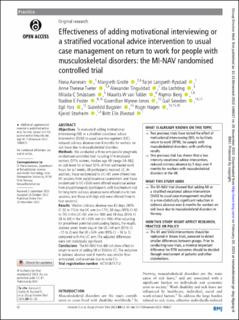| dc.contributor.author | Aanesen, Fiona | |
| dc.contributor.author | Grotle, Margreth | |
| dc.contributor.author | Rysstad, Tarjei Langseth | |
| dc.contributor.author | Tveter, Anne Therese | |
| dc.contributor.author | Tingulstad, Alexander | |
| dc.contributor.author | Løchting, Ida | |
| dc.contributor.author | Småstuen, Milada Cvancarova | |
| dc.contributor.author | van Tulder, Maurits W. | |
| dc.contributor.author | Berg, Rigmor | |
| dc.contributor.author | Foster, Nadine E. | |
| dc.contributor.author | Wynne-Jones, Gwenllian | |
| dc.contributor.author | Sowden, Gail | |
| dc.contributor.author | Fors, Egil Andreas | |
| dc.contributor.author | Bagøien, Gunnhild Irene | |
| dc.contributor.author | Hagen, Roger | |
| dc.contributor.author | Storheim, Kjersti | |
| dc.contributor.author | Øiestad, Britt Elin | |
| dc.date.accessioned | 2023-02-22T12:17:46Z | |
| dc.date.available | 2023-02-22T12:17:46Z | |
| dc.date.created | 2022-11-29T20:27:32Z | |
| dc.date.issued | 2022 | |
| dc.identifier.citation | Occupational and Environmental Medicine. 2022, 80 (1), 42-50. | |
| dc.identifier.issn | 1351-0711 | |
| dc.identifier.uri | https://hdl.handle.net/11250/3053261 | |
| dc.description.abstract | Objectives: To evaluate if adding motivational interviewing (MI) or a stratified vocational advice intervention (SVAI) to usual case management (UC), reduced sickness absence over 6 months for workers on sick leave due to musculoskeletal disorders. Methods: We conducted a three-arm parallel pragmatic randomised controlled trial including 514 employed workers (57% women, median age 49 (range 24–66)), on sick leave for at least 50% of their contracted work hours for ≥7 weeks. All participants received UC. In addition, those randomised to UC+MI were offered two MI sessions from social insurance caseworkers and those randomised to UC+SVAI were offered vocational advice from physiotherapists (participants with low/medium-risk for long-term sickness absence were offered one to two sessions, and those with high-risk were offered three to four sessions). Results: Median sickness absence was 62 days, (95% CI 52 to 71) in the UC arm (n=171), 56 days (95% CI 43 to 70) in the UC+MI arm (n=169) and 49 days (95% CI 38 to 60) in the UC+SVAI arm (n=169). After adjusting for predefined potential confounding factors, the results showed seven fewer days in the UC+MI arm (95% CI −15 to 2) and the UC+SVAI arm (95% CI −16 to 1), compared with the UC arm. The adjusted differences were not statistically significant. Conclusions: The MI-NAV trial did not show effect on return to work of adding MI or SVAI to UC. The reduction in sickness absence over 6 months was smaller than anticipated, and uncertain due to wide CIs. | |
| dc.description.abstract | Effectiveness of adding motivational interviewing or a stratified vocational advice intervention to usual case management on return to work for people with musculoskeletal disorders: The MI-NAV randomised controlled trial | |
| dc.language.iso | eng | |
| dc.relation.uri | https://oem.bmj.com/content/80/1/42 | |
| dc.title | Effectiveness of adding motivational interviewing or a stratified vocational advice intervention to usual case management on return to work for people with musculoskeletal disorders: The MI-NAV randomised controlled trial | |
| dc.title.alternative | Effectiveness of adding motivational interviewing or a stratified vocational advice intervention to usual case management on return to work for people with musculoskeletal disorders: The MI-NAV randomised controlled trial | |
| dc.type | Peer reviewed | |
| dc.type | Journal article | |
| dc.description.version | publishedVersion | |
| dc.source.pagenumber | 42-50 | |
| dc.source.volume | 80 | |
| dc.source.journal | Occupational and Environmental Medicine | |
| dc.source.issue | 1 | |
| dc.identifier.doi | 10.1136/oemed-2022-108637 | |
| dc.identifier.cristin | 2084722 | |
| dc.relation.project | Norges forskningsråd: 280431 | |
| dc.relation.project | Norges forskningsråd: 328657 | |
| cristin.ispublished | true | |
| cristin.fulltext | original | |
| cristin.qualitycode | 2 | |
